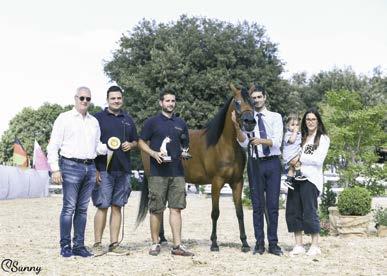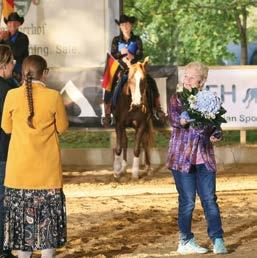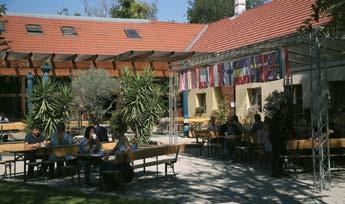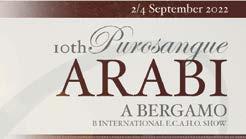25 years with you














































Proudly bred and owned by Al Shiraa Arabians



Photo: Antonia Bautista
n. 5/2022 October pubb. bimestrale iscr. trib. di Milano n. 732 del 18/09/99 - Spedizione in A.P. 70% Milano



Alim Editrice s.n.c. Via Ressi, 22 - 20125 Milano - Italy Tel. +39 02 36762850 info@tuttoarabi.it @tuttoarabi_magazine @tuttoarabi_showsandevents www.tuttoarabi.com

Direttore Responsabile / Publisher Simone Leo - (leo.simon@tiscali.it)
Editore / Editor Fabio Brianzoni - (fabiobrianzoni56@gmail.com)


Ufficio Contabilità / Account Office Barbara Belloni - (amministrazione@alimeditrice.it)
Ufficio Abbonamenti / Subscription Office Barbara Belloni
Morhaf Al Assaf, Ataya Group, Simone Bergamaschi, Ewa Imielska-Hebda, Sweet photogrphy, Sunny Sassudelli, Mousarreza Shokouhi, Christian Kellner
Fabio Brianzoni, Sissi Chat, Joseph Ferriss, Jolanta Gębka, Samar Ismail, Giorgia Mauri, Evangeline Parker, Sweet photogrphy

Stampa / Printed by AGF S.p.a. - San Giuliano M.se - Milano (Italy)
Pubblicità / Advertising
Alim Editrice - Simone Leo (+39 348 5640190)

























Small in structure and big in heart, there was one name who took the Arabian racing world by storm. For those who know the tracks well, the name *Wiking (Etap x *Wilma by Pietuszok) is a familiar sight, and even now his name continues to echo around the Arabian tracks, proving time and time again the function and dedication of the Arabian horse that sits alongside the beauty and softness.
Born to Janow Podlaski in January 1979, this true powerhouse was only 14.3hh but made the biggest impact. His time at Janow was spent with 3 seasons racing in Poland, where he won important stakes such as: Comet, Kuhailan, Haifi, Witez, Ofir and Kurozwęki. His Polish race record finished at 8-4-1.
He was sold to the US in 1984 at 5 years old to Mr Jim Wagner of the Libra Co, Michigan for a reasonable sum. This was after catching his eye in a “silent auction” of which he did not reach reserve price. He was the first Arabian that Jim Wagner had purchased, and what an import *Wiking turned out to be! He was eventually sold to Dr James Budd who organised the ownership of Wiking under partnership with Town & Country Farms - represented by the Courtelis Family. After some time, the Courtelis Family bought all shares for *Wiking and remained his sole owner until the day of his death.

During his time in the US he won just under $100,000 in his racing career, being named playfully as the “Chairman of the Board” of Arabian racing. His US race record was an incredible 12-6-1. He was named IAHA Arabian Race Horse of the year in 1985.

After his race career finished, *Wiking was not yet done with making his mark. He went on to sire highly successful race champions and by the end of 2004 his progeny had won a total of over 8 million US Dollars, which is the largest amount ever won by an Arabian’s progeny. As a bonus, not only were his progeny great winners on the track, they also were able to breed successful progeny of their own. He eventually sired 337 starters, of which 262 were winners.

*Wiking’s sire, Etap (Celebes x Etna by Faher) tragically died at only 8 years old due to an accident, which makes *Wiking’s existence all the more so special. Etap was bred and owned by Janow Podlaski and managed to sire around 30 foals before his death. Though his quantity of progeny was not large, his quality certainly was.
Celebes, the sire of Etap and grandsire to *Wiking was a horse with his own fascinating history, which included being a circus performer as well as being regarded as one of the best Witraz sons of his time. You can read more about Celebes here:



*Wiking’s dam, *Wilma (Pietuszok x Worskla by Laur) was born in 1963 to Janow Podlaski before being exported to the USA.
Her own sire, Pietuszok was a Priboj son out of a Taki Pan mare. Pietuszok was bred by the Tersk Stud, Russia and began to sire successfully in the racing barn when he was transferred to Poland in 1958.

*Wilma pictured above by Jerry Sparagowski.

Monarch AH (*Wiking x Sasanka by Almifar) pictured at 30 years old by Sharon Meyers.
Over a course of 3 years, Monarch collected an impressive record and was also voted Darley Horse of the Year in 1991.

DA Adios+/ (*Wiking x Sanibel IA by Samtyr.)

A 5 times Darley Champion as well as WAHO horse of the year. Adios won every major stake and racked up earnings of $622,048 over his race career - the highest in American Arabian Racing history.


Photographed by D Mihaloff.
Kan You Run (*Wiking x Kenia by El Paso) who collected 15 wins under his hooves, including stake wins and stake placings.
Photo sourced on the web.
It comes as no surprise that Dixie enters the Arabian Horse Trust Racing Hall of Fame, with 40 races ran she collected results of 17-10-4 and won in total $281,689.

Photo sourced on the web.
The Wiking (*Wiking x Nadoba by Ariel)


Another high earner of *Wiking progeny, The Wiking won over $200,000 throughout multiple prestigious races.
Photo sourced on the web.


(The Wiking x Sucha by Charmer), granddaughter of Wiking and a multiple race winner.
She was also granted the title of AHS Premium mare.

Pictured by Light Rays Photography.
Al Nasr (Way To Go x Mangalie D’Albret by Manganate), grandson of *Wiking and winning 3 of his races as a 3 year old before going on to continue an impressive sire line.






















































































 (Majd al Rayyan x Frasera Mashara) Dahmah Shahwan
(Majd al Rayyan x Frasera Mashara) Dahmah Shahwan















































































































When a group of students graduate from high school or college, the year of their graduation is commemorated and is given a name to remember by its year of the event such as “the class of ‘56”. Each would go their own way afterward and some would develop fame and or fortune and have an impact either locally or broader. Such classes would have reunions a decade or so later to gather and see what became of everyone from that class. Reflecting on this got me to wondering, what about foaling crops of horses? I became curious about this decided to look into the “Class of 1956” in Egypt, what horses were born that year and what became of them?
Bint Kamla (El Sareei x Kamla) first born foal from the “class of 1956” at the E.A.O., she created a dynasty in from her daughters Lotfeia and Nazeema. Judith Forbis photo.

1956 was a point in time of great development in the world as well as great new challenges. It had been about a decade since World War II ended. Countries were rebuilding and some governments were changing and new ideas were developing regarding how to govern its people. In America, it was a period of great economic and industrial growth. American cars were getting bigger and beginning to sprout the unusual “fins” while European cars came in two types, the practical rugged small cars and the dramatic hand built ones such as Rolls Royces and Ferraris, but none sported “fins.”


The middle East was a time of reformation and sometimes conflict. Egypt was now governed by a new system led by Gamel Abdel Nasser, based on invigorated Egyptian nationalism and the desire for independence from foreign countries. 1956 was only a few short years after the end of Egypt’s long monarchy which meant that the Royal Inshass Stud of Arabian horses was dispersed and some would become a part of the government breeding program, formally called the Royal Agricultural Society (R.A.S.), now renamed the Egyptian Agricultural Organization (E.A.O.). It was a challenging year for Egypt but nonetheless, the E.A.O. managed to produce 32 Arabian foals in 1956 at their various stud farms. Private breeders in Egypt only managed a few foals. Hamdan stud produced three mares Okt El Fol (Hamdan x Bint Barakat), Bint Folla (Hamdan x Folla) and Bint Futna (Hamdan x Futna) from his prized Tahawi bred mares. All three would go on to establish families internationally. Al Badeia stud only produced one foal, Bint Shams (El Sareei x Shams) in 1956.

Among Badr’s six foals in the class of 1956 was the Inshass bred mare Mona whose daughter Hanan pictured here would become a world famous family. Rik VanLent photo.

Putting things in perspective in 1956, legendary Ansata Ibn Halima and Aswan had not yet been born and Moniet El Nefous was only ten years old but had already produced five foals, including 3 of her famous daughters. Nazeer’s first two get to leave Egypt were the stallions Hadban Enzahi and Ghazal who went to Germany the year before and were at the time too young to create a sensation. No Nazeer bred horses had yet reached American shores in 1956.
27 Ibn Galal-V, the splendid chestnut granddaughter of Rida from the class of 1956.

She is also a granddaughter of Mohga from the same class of 1956.
So many champions trace to this breeding. Marion Richmond archive photo.

How did the breeding program at the E.A.O. look in 1956? Five E.A.O./R.A.S. stallions were used that year. The famed Nazeer was one of them but had not yet become world famous. The others used included El Sareei, Balance, Sid Abouhom, and El Nasser. How were they used? Nazeer and El Sareei each sired 9 foals, and Balance, Sid Abouhom and El Nasser sired one each. So who sired the remaining foals? Four stallions obtained from the dispersal of the Inshass stud were used by the E.A.O. Among them were the not yet famous Anter, sire of one foal, and Sameh, sire of two. Quite remarkably the third most heavily used stallion at the E.A.O. in 1956 was the Inshass bred stallion Badr who was a son of two desert bred horses given to the King of Egypt by Midhat Bisharat Bey. Badr sired six horses. From the class of 1956, his most famous daughter would be Mona out of the Inshass bred mare Mahdia. Mona would produce the stallion Maher for the E.A.O. and the beautiful Morafic son Bilal for Shams El Asil stud in Egypt. She also produced two magnificent daughters, Serenity Montaha, the full sister to Maher, and the exquisite Hanan by Alaa El Din whose name would become among the most celebrated of all Egyptian mares. If Hanan was any indication, the class of 1956 was shaping up to be an historic one.

The lovely Bint Dahma, known as Kismat in Egypt, from the class of 1956. She was imported to the U.S. in 1958 by Richard Pritzlaff and became an important mare line. Ferriss archive.

Nahlah, an absolutely beautiful and charming mare the product of two members of the class of 1956, Morafic and Mohga. She was twice U.S. National Top Ten mare and dam of National winners. Judith Forbis photo.
What mares produced at the E.A.O. in 1956? Of the producing mares, 21 were of E.A.O./R.A.S. breeding and 11 were from Inshass bloodlines. From the 21 producing E.A.O. mares in 1956, the lovely Sheikh El Arab daughter Kamla would produce Bint Kamla (x El Sareei) who not only produced the E.A.O. stallion Shaarawi but also the prominent mares Nazeema (x Alaa El Din) dam of the magnificent Ibn Nazeema, and Lutfia (x Alaa El Din) founding mare for both the Babolna stud in Hungary and NK Katharinenhof in Germany. Other El Sareei daughters in the class of 1956 would eventually become famous for their influence. One of them was Bint Kamla’s three-quarter sister, Rida (El Sareei x Rouda) even though she had only one foal. Rida’s only foal was the filly Hosna (x Ibn Maisa) who went to Babolna where she had many foals among which included the supreme 27-Ibn Galal-5, the splendid chestnut mare who became Australian National Champion. This is the dam line of such renowned international champions as Simeon Shai, Simeon Sadik and Simeon Sehavi to name a few. Another El Sareei daughter from the class of 1956 was a fine little chestnut named Kismat in Egypt but was among the first E.A.O. horses to come to America via Richard Pritzlaff where she was named Bint Dahma, a daughter of Dahma II, the first born Nazeer daughter. Bint Dahma founded a strong family in America. Her granddaughter Sariella produced SAR Ibn Moniet, an important sire. Bint Dahma also has descendants throughout Europe, the Middle East, Israel and South America. In 1956 the El Sareei daughter Rashida (x Yashmak) was born and she would establish an international family through her daughter Nazic (x Morafic). El Sareei created fame one more time in 1956 by siring the lovely black mare Mohga, a daughter of legendary Yosreia who would later create the incomparable stallion Aswan. Mohga is dam of one of the most beloved mares in America, Nahlah (x Morafic) many times a popular show winner. But Mohga’s sons also claimed fame including the extraordinary European sire Ibn Galal. His full brother El Mohktar became a movie star playing an important role in the popular movie The Black Stallion.


What about the stallions from the class of 1956? One of the old R.A.S. stallions still in use was the great racehorse Balance who got one son in 1956. That was the stallion Nasralla from the mare Sehr. In the tradition of great racing Nasralla raced well and sired important race horses and eventually sired 48 get for the E.A.O. Yet his eventual claim to fame would become via his many fine daughters, nearly every one of which has been used for breeding, especially Baheia, in the pedigree of the world’s most prolific straight Egyptian sire, Thee Desperado.
Nasralla, (Balance x Sehr) one of three important E.A.O. stallions from the class of 1956, he is found today in many thousands of Arabian pedigrees. Judith Forbis photo.


The exotic Morafic (Nazeer x Mabrouka) one of only two Nazeer get from the class of 1956 to be used for breeding and now a desired world-wide name in Arabian pedigrees. Johnny Johnston photo.

Ironically the most famous sire, Nazeer, produced 7 out of 9 foals in 1956 who were not used for breeding! The only two of his get that year that were used for breeding at the E.A.O. would eventually become among the most famous Arabian stallions of all time, Alaa El Din (x Kateefa) and Morafic (x Mabrouka). Indeed by all accounts in photo, film and descriptions by people who saw these two stallions they were spectacular Arabians and indeed they were unforgettable. While the noble Alaa El Din became the patriarch of superior producing mares, Morafic won the title of patriarch of both genders although, arguably Morafic also has created one of the largest sire lines within the Arabian breed.

Looking back now it is fascinating to see what became of the class of 1956, a year that must have seemed uncertain at the time in Egypt, with conflict on its borders and challenges within. Somehow the spirit of the Arabian horse seems to transcend even the most difficult of times and we are fortunate that the horses and the people who loved them in 1956 have survived to become a part of the legacy of today’s Arabian horses. In the near future I will return to this subject to revisit other years to see how they played out into the future.














We

Thanks
Miles Buckley


































































































































































































































































































































































































































































































































































































